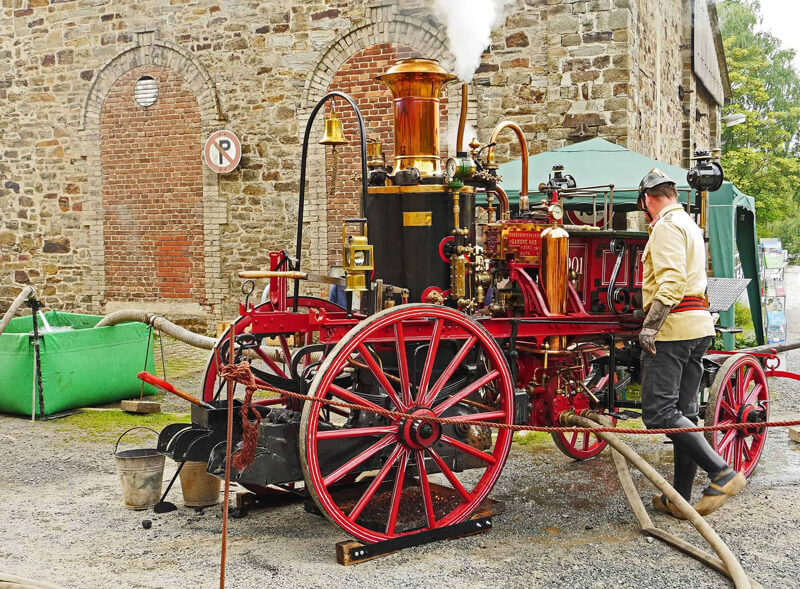Members of the community would be in charge of monitoring the area for fires and would alert people by blowing a whistle or ringing a church bell. The members of the community would then work together to put out the fire. However, as time went on and communities became larger and larger, this system became impractical. In the 1850s, a type of wooden rattle was developed in Australia that was shaken to wake people up when there was a fire.

In response to the constant fires plaguing ancient Rome, Caesar Augustus created an organization of men tasked with patrolling the streets with buckets filled with water. He modelled this group after a fire brigade of a similar nature in Alexandria, Egypt. This approach focused on fighting fires as they broke out, because there was no other method of fire detection or prevention. Fires could only be detected once the building was largely consumed, and fought as they declined—essentially, after all the damage was done.
Then the police force in 17th century New York City hired men to walk the streets looking for fires while carrying buckets on ladders.
Large stately homes used these systems


Sounding the alarm: the invention of the fire alarm system
Samuel Morse invented the telegraph in 1837, and it didn’t take long for others to take advantage of the first form of long-distance communication. In 1852, Moses Farmer and William F. Channing designed two fire alarm boxes, each of which contained a telegraphic key. When someone detected a fire, they would crank the handle that was attached to the fire alarm box, which would then send the details of the fire alarm box number to a central alarm station. As soon as the telegrapher at the station received the message they would notify the fire department response team of the box location.
 Fire alarms were first invented in 1852, simply designed as a bell in a box attached to a crank.
Fire alarms were first invented in 1852, simply designed as a bell in a box attached to a crank.
These became a target for vandals, who would often try to break into the fire station as the engine/cart was called out.
To combat this, the design was changed and to activate the alarm you had to physically lock yourself into the device!
This system took the “central bell tower” idea and turned it into a “central station.” For the first time in history, dispatch times considerably improved because of the ability to pinpoint the location of a fire.
Dr. Channing also drew an important comparison between the increasing complexity of electrical systems to that of the nervous system of the human body. His sense that multiple “nerves” (field devices) would report information to a “brain” (control panel/central station) would lay the groundwork for commercial and residential fire alarm systems decades into his future.
Even with the rollout of new city-wide fire alarm systems, cities were still developing faster than they safely should have. The Great Chicago Fire in 1871 killed hundreds and devastated the city’s infrastructure, underscoring the need for buildings to be built to a certain standard to prevent fire outbreak and spreading. The new focus on safer building design brought to fruition the first set of accepted fire building codes. While this helped improve fire safety in residences and commercial buildings, firefighting was still predicated upon someone seeing a fire, reporting it, and then the mobilization of the fire department—and all the while, the fire raged on.
Back in 1890, Francis Robbins Upton patented the design of the modern fire alarm. However, his design was largely unpopular and received little attention at first. But it was not long before people recognised the importance of this fire alarm and it became widely used, especially in cities and large towns where fire departments needed to respond to fires quickly and could not simply rely on the community to be vigilant.
It took the harnessing of electrical power to bring about the age of early detection. Francis Robbins Upton, a partner of Thomas Edison’s, patented the “Portable Electric Fire-Alarm”—the world’s first hand pull station. The turn of the 20th century saw the invention of other detection devices—the smoke detector and carbon monoxide detector—that would eventually comprise essential components of modern fire alarm systems. While the technology existed over a hundred years ago, the devices were often too expensive to produce, or too large for viable use in a home or business. It would take improvements in manufacturing and fire alarm technology before the modern fire alarm system could take on the form we’re familiar with today.
The modern fire alarm system: early detection, early response
 Ionized smoke detectors (using trace amounts of radioactive particles to detect smoke) were developed for use in 1951 but were too large and costly for even most commercial properties. It wasn’t until 1955 that compact, functional heat detectors began use in homes. Cost-effective, battery-powered smoke detectors were developed in 1965 by Duane Pearsall and Stanley Peterson, and by 1975 the devices were being mass-produced for consumer use. Battery-powered carbon monoxide detectors were developed en masse in the early 1990s, and the first combination smoke/carbon monoxide detectors hit the market in 1996.
Ionized smoke detectors (using trace amounts of radioactive particles to detect smoke) were developed for use in 1951 but were too large and costly for even most commercial properties. It wasn’t until 1955 that compact, functional heat detectors began use in homes. Cost-effective, battery-powered smoke detectors were developed in 1965 by Duane Pearsall and Stanley Peterson, and by 1975 the devices were being mass-produced for consumer use. Battery-powered carbon monoxide detectors were developed en masse in the early 1990s, and the first combination smoke/carbon monoxide detectors hit the market in 1996.
For the first time in history, both businesses and homes were able to both locally alert occupants to a fire and send the signal to a monitored control panel. This period of time saw an emphasis on the development of central stations who could actually pinpoint specific locations and alarm signals, relaying that to appropriate dispatchers and fire departments. Firefighting tactics shifted dramatically from fighting declining fires to trying to douse flames in the development phase—before the fires could transform into the block-burning fires of yesteryear. Because of this dramatic shift, fire fatalities have steadily dropped over the course of the past fifty years.
The first modern fire alarms were developed in the 21st century. These fire alarms work without wires and use a range of different types of modern technologies such as cellular transmitters, private radio systems and digital communicator systems. This modern technology allows the fire alarm signal to be transmitted to the nearest fire department in a matter of seconds so that a fire fighting team can be dispatched.


